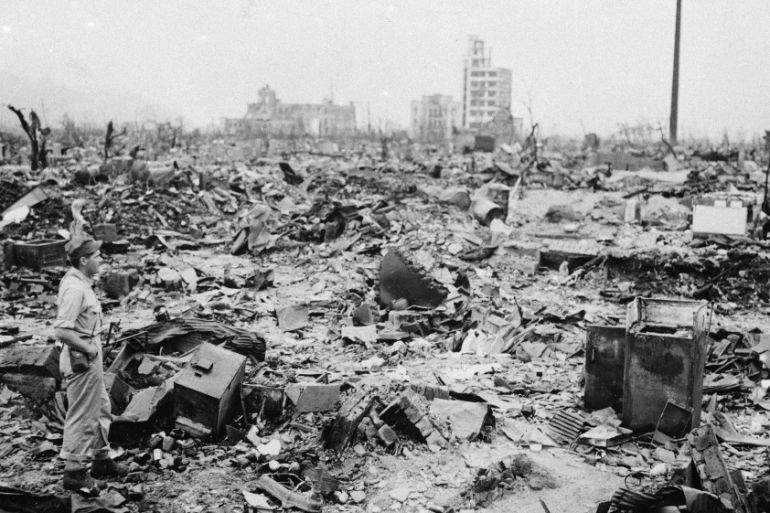No more nuclear weapons!
A total ban on use has been a traditional reaction to particularly cruel weapons of war; now it’s nuclear weapons’ turn.

The nuclear bomb that destroyed Hiroshima opened a new grisly chapter in warfare – and we have still not closed it.
Even though today more attention is paid to the process of climate change and the risk that human civilisation may be committing a slow suicide, we must not ignore that the number of nuclear weapons – still somewhere near 20,000 – is enough to wipe us out in a quick blast.
Keep reading
list of 4 itemsRwanda genocide: ‘Frozen faces still haunt’ photojournalist, 30 years on
Underground tunnels found in Israel from Jewish revolt against Romans
Lost in Orientalism: Arab Christians and the war in Gaza
For 70 years the world has asked in vain for the total abolition of nuclear weapons. We’ve failed up to this point, so perhaps we should be trying a new approach.
RELATED: Hiroshima and Nagasaki: Timeline to disaster
Historically, a ban on use has been a traditional reaction to particularly cruel weapons.
The use of dum-dum bullets was prohibited and the terrible experiences of gas warfare in World War I led to a ban on use through the 1925 Geneva Protocol.
In fact, there was no use of gas weaponry in theatres of war during World War II, but was this because of respect for the prohibition or because states retained stocks of gas and other chemical weapons and any use risked retaliation in kind? We do not know.
Banning nuclear weapons
The International Court of Justice has declared that almost any use of nuclear weapons would be prohibited under already existing international law and some now urge that a convention should be concluded completely banning the use of nuclear weapons.
|
|
| Inside Story: Nuclear deal, conventional arms race? |
While nuclear weapons states would be unlikely to join such a convention, and would argue that the approach is not viable, a large number of the remaining states would become party to such a ban, adding to the taboo of any use.
The fear of use remains ever-present and is completely justified so long as any nuclear weapon physically exists anywhere.
Accordingly, we should welcome the movement urging a global goal of zero nuclear weapons.
While that goal may seem too ambitious to some, we should recognise that even at global zero, the genie of knowledge is forever out of the bottle, enabling the production of new weapons.
Only an effective order for international peace and for conflict resolution, comparable to what we have attained within stabilised nations, can give us full assurance.
Bloated nuclear arsenals
Former US President George H W Bush thought he saw the dawning of a new international order when, at his initiative, a United Nations mandated armed intervention ousted Saddam Hussein’s forces from Kuwait in 1991.
During a short period after the end of the Cold War, much progress was also made in arms control and disarmament.
The US and the Soviet Union eliminated whole categories of tactical nuclear weapons and made drastic cuts in their bloated nuclear arsenals.
Today, regrettably, this hopeful evolution is reversed.
President Barack Obama’s drive for broad disarmament and the important 2010 agreement – the New Strategic Arms Reduction Treaty (New START) – that set ceilings for the number of nuclear weapons and carriers that can be deployed in the US and Russia, have been followed by new armed conflicts and tensions – in the Ukraine, in the Middle East, in East Asia, and in Africa.
|
Most non-nuclear weapon states in the world have joined as parties and lived up to their promise to stay away from nuclear weapons. The world would undoubtedly be an even more dangerous place if they had not done so.
|
The current outlook is bleak – much rearmament has occurred while the UN Forum for Disarmament talks in Geneva remain in a coma-like state. Is there any ray of hope 70 years after Hiroshima?
Global pact for elimination
The Nuclear Non-Proliferation Treaty (NPT), concluded in 1968, has been seen as a global pact for the elimination of nuclear weapons: The non-nuclear weapons state parties promised to stay away from the weapons, while nuclear weapons state parties promised to do away with their weapons.
At this time, a balance sheet will show that the treaty’s aim of preventing a further horizontal spread of nuclear weapons has been rather successful.
The five nuclear weapons state parties (China, France, Russia, the UK, and the US) have been eager to strengthen the means to prevent such spread, but their own commitment to negotiate towards disarmament has had little result.
Most non-nuclear weapon states in the world have joined as parties and lived up to their promise to stay away from nuclear weapons.
The world would undoubtedly be an even more dangerous place if they had not done so.
However, two of them – Iraq and Libya – tried to develop nuclear weapons in breach of their commitment and were prevented from doing so, while one state – North Korea – withdrew from the treaty and instead have developed and tested weapons.
Far from eliminated
Four states – India, Israel, Pakistan, and South Africa – refused to join the treaty and developed nuclear weapons of their own.
Later, South Africa eliminated the weapons it had, and Kazakhstan and Ukraine transferred theirs to Russia.
The net result is that while the nuclear arsenals of the world are far from eliminated, as was the aim of the treaty, and are rather a thousand times larger and more potent than 70 years ago, the number of nuclear weapons states in the world has increased by only four.
How should we view the recent deal reached between the P5 and Iran?

My reading is that Iran has committed to scaling down its nuclear programme to what it actually needs and has given it a size and a structure that can regain the confidence of the world that its aim is only for peaceful use.
If it is faithfully implemented by all, it should allow a reduction of tensions and a lowering of arms expenses in the region.
It should be followed by cooperation – especially in nuclear safety – between the growing number of states in the region that will rely on nuclear power rather than oil to generate the electricity that they need.
Hans Blix is an international lawyer and served as the foreign minister of Sweden in 1979, the director general of the International Atomic Energy Agency (IAEA) between 1981 and 1997, and headed the UN inspections in Iraq in 2002-2003.
The views expressed in this article are the author’s own and do not necessarily reflect Al Jazeera’s editorial policy.
